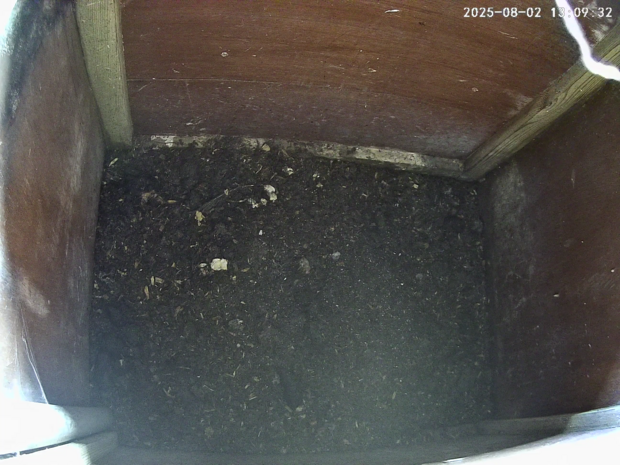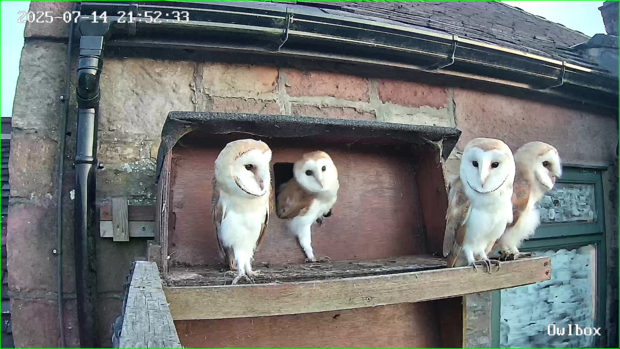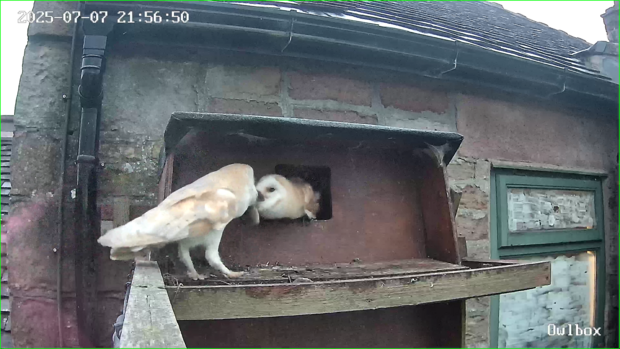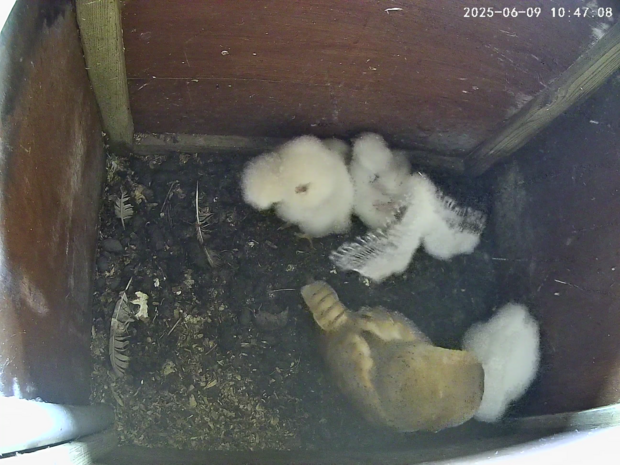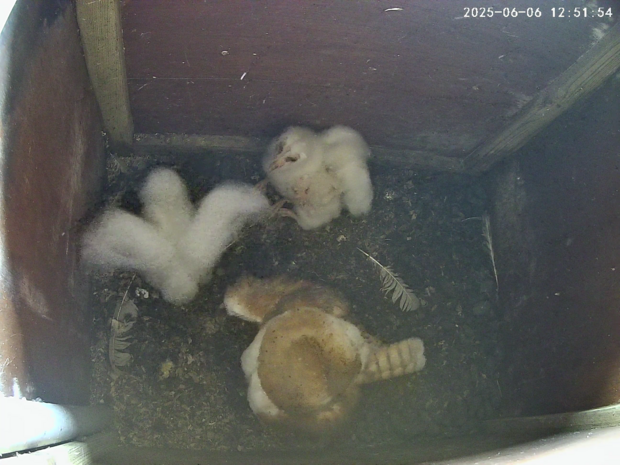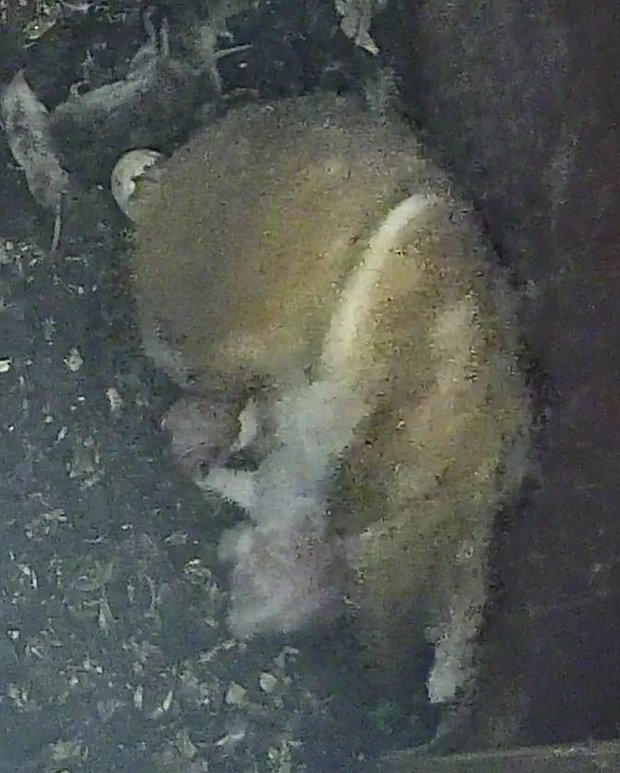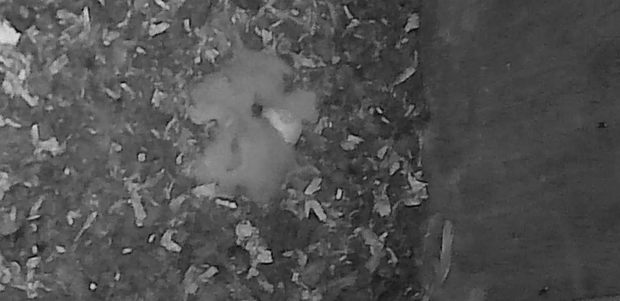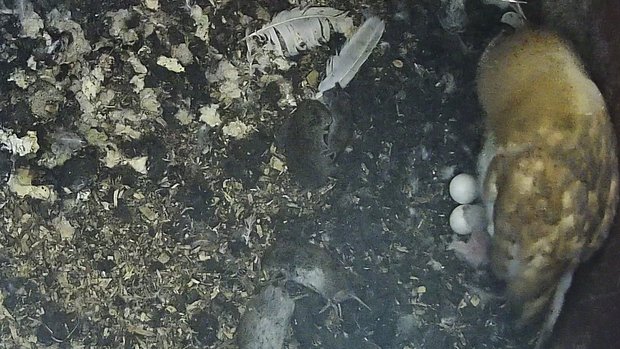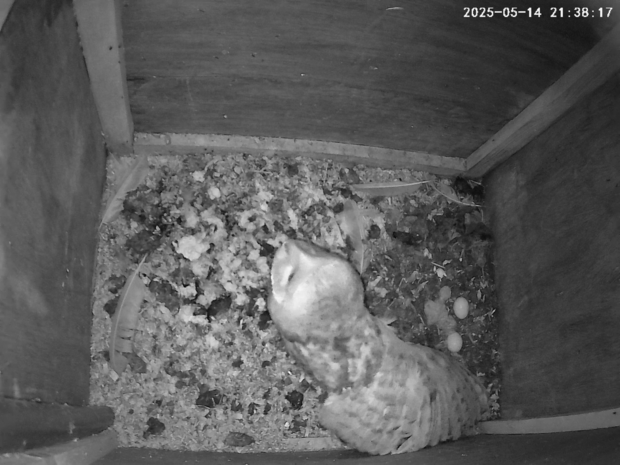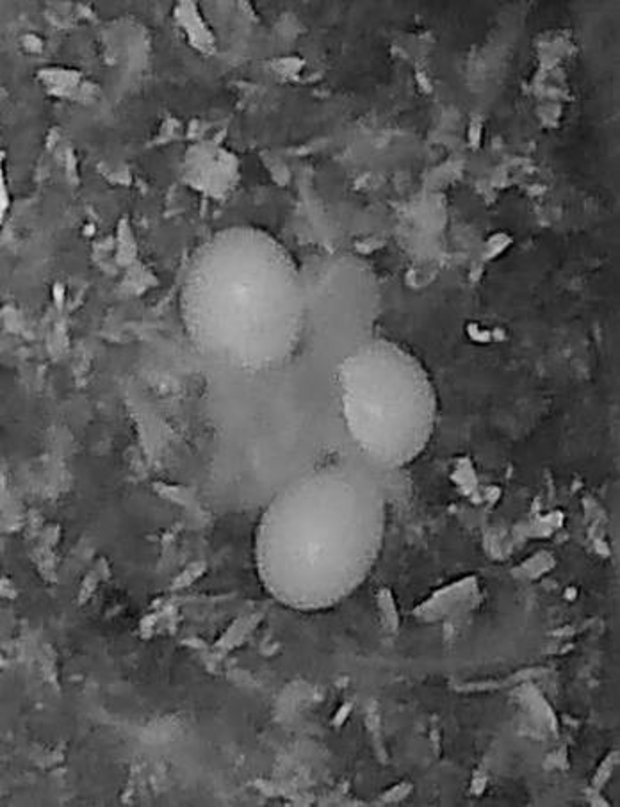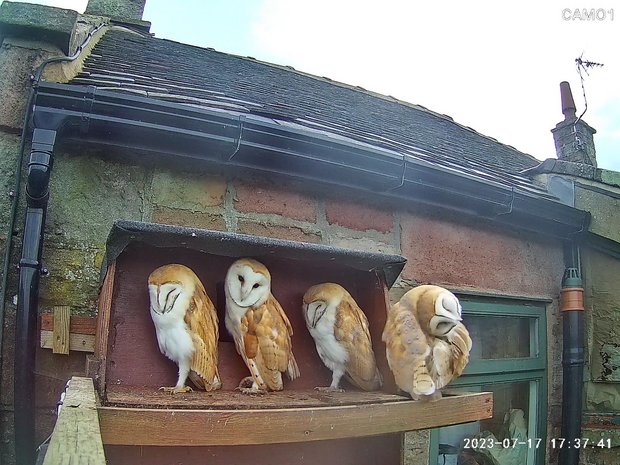A blog to share barn owl and other wildlife and general news about the Retreat and its environment.
Click on a photo to see a larger version.
All four barn owlets have all fledged successfully
02. August 2025, Wildlife
We had four eggs laid. All four hatched and all four owlets have grown and fledged successfully. This morning there are no owlets roosting in the box. Last night one owlet was on the ledge but had to go hunting for itself as, for the first time, no parent brought any prey to feed it.
Over the last few days occupancy has been intermittent, and it is possible that one or even two of them may visit over the next few days, but soon they will be dispersing away from this area to find an unoccupied territory that they can make their own.
We have enjoyed seeing them all flying around the area, and perching on the ledge, between dusk and dawn for the last few weeks. Until next year…
READ MORE: All four barn owlets have all fledged successfully (with more images)
All four owlets can now fly up and out of the nest box
14. July 2025, Wildlife
This evening, for the first time, the fourth and youngest owlet, 54 days since hatching, has managed to fly up from the base of the nest box and gain purchase on the exit hole. Its first three siblings have been exiting the box for a few days now, particularly the first two, achieving this for the first time at 56 days, 56 days, and 55 days respectively.
The first two hatchings have quickly become confident flyers. The third-hatched, at the right of the group (with its first outing being only two days ago, and still quite downy on the abdomen) is less confident but is nevertheless flying around.
READ MORE: All four owlets can now fly up and out of the nest box (with more images)
At 56 days since hatching, the first hatched owlet has managed to fly up the box exit for the first time. It didn't venture out on to the ledge - it just clung on to the exit and looked around.
The parent twice brought it prey and tried to feed it as it clung there, but both times the prey was dropped onto the ledge. Perhaps the owlet was too focussed on clinging to the exit to manage to coordinate a food pass!
Soon it will be venturing out onto the ledge, and starting to fly around. It will return to the box, because barn owl parents only feed those at the box, not any that have left and not returned (even if they are stuck on the floor and can't get back to the box).
Expect a second owlet to also achieve this same milestone in the next couple of days.
The barn owlets are developing, fledging will start soon
27. June 2025, Wildlife
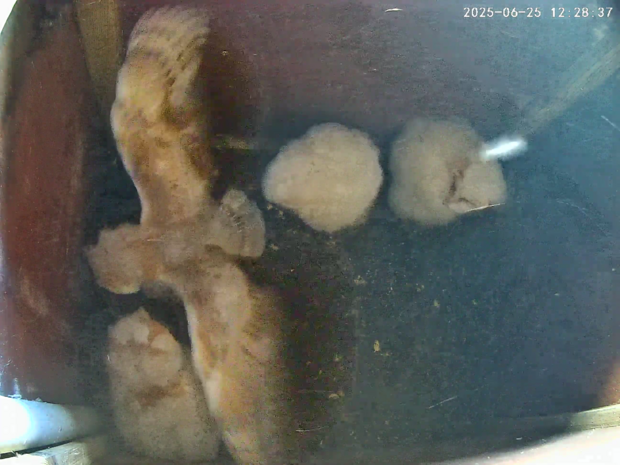
The barn owlets are developing well and the first fledging is expected in around ten days.
To exit the nest box they need to be able to fly up to the exit hole which is about 60cm above the floor of the box. The box depth is calculated so as to be difficult for them to exit before 56 days old. This is because if they leave the box too early, before they are good enough at flying to get back to the nest box, they will starve. Barn owl parents do not feed their young on the ground, they feed only those in or on the box. (This is different to tawny owls who find their young and feed them wherever they are).
The eldest owlet will be 56 days old just nine days from now. Expect to see a lot of wing exercising and attempted flying between now and then. Already I've seen the eldest one leave the bottom of the box briefly by flapping its wings.
READ MORE: The barn owlets are developing, fledging will start soon (with more images)
Our four barn owlets are active and developing
09. June 2025, Wildlife
The four barn owlets seems to be thriving and active.
These barn owlets now range in age from 4 weeks down to 19 days. They are beginning to replace their down with feathers. e.g. look at the video at about 12 seconds in.
The fourth and youngest is not so visible early in the video - it tends to keep underneath its siblings, perhaps for warmth as it is still not fully covered in down. Later in the video it is away from the others and easier to see.
READ MORE: Our four barn owlets are active and developing (with more images)
Our four barn owlets are doing well so far
07. June 2025, Wildlife
All four eggs hatched, and all four owlets are being fed by the parents. They have all turned white and fluffy, having been naked and pink initially.
The male barn owl is still not very reliable at hunting for them, occasionally not turning up at all and some nights only bringing 2-3 voles (and other nights bringing 10 or more).
The female sometimes also goes out hunting at dusk and/or at dawn, but that is higher risk because in daylight predators may attack either her or the owlets in the box. Again this morning she was chased back to the box by a magpie trying to steal her prey.
The second photo of her with prey was from 06:22 yesterday.
READ MORE: Our four barn owlets are doing well so far (with more images)
The fourth barn owl egg has hatched this morning.
The image attached from 10:42 shows half the shell discarded to the top-left of the female's head, with the owlet still sitting in the other half of the shell! (just below the female's head).
The male owl has not been resident in the box, but visits each night and brings voles to the female. On one or two nights his haul was a bit meagre, but most nights he is bringing enough to feed the female, and also to leave her some more which she tears up to feed to the small owlets.
Over the next few weeks they will grow quite rapidly and surprisingly soon they will be fed whole voles. By about four weeks they usually need larger supplies and the female starts going out to hunt as well.
The mother tries to brood them and keep them warm. She sits with her wings spread a little wider to cover them. As there are now four of them to contain, and those four will grow quite quickly, it is an impossible task and you will more and more often see escapees spilling out from under her, or popping up between her trunk and wings. Watch them on the live camera.
We wouldn't expect the owlets to leave the box until about 56 days after hatching. That is how long it takes for them to grow big enough to be able to fly up to the box entrance/exit, which is deliberately high up so that once they leave the box they can fly back to it instead of being stranded on the ground. (Unlike tawny owls, barn owl parents will ignore and not feed any young on the ground, so they would perish from starvation or predators if they are not strong enough to fly back to the box).
READ MORE: The fourth and final barn owl egg hatching caught on camera (with more images)
Third barn owl egg hatches successfully
17. May 2025, Wildlife
The third egg has hatched this evening.
Not a very clear picture, but there are three hatchlings and one egg.
One more egg to hatch, due in the next 3-5 days.
Our second barn owl egg has hatched this evening
14. May 2025, Wildlife
Earlier this evening a second barn owl egg has hatched.
The third hatching is due in 3-5 days.
The two day barn owl hatchling is growing and active
14. May 2025, Wildlife
Not yet 48 hours since hatching, the young barn owlet (the pink blob next to the remaining eggs) is clearly growing and moving - a good sign.
READ MORE: The two day barn owl hatchling is growing and active (with more images)
Our first barn owl egg hatches - our first hatchling
12. May 2025, Wildlife
The first of our four barn owl eggs hatched about an hour before this photo was taken. It was right on time, having been laid 30 days ago, and the average hatching time being after 30-32 days incubation.
The hatchling is the pink blob under the owl, next to the eggs.
The male barn owl has not been pulling his weight when it comes to hunting and bringing prey to the box. Let's hope he ups his game now that he is a father!
2023 Barn owl nesting success - 4 eggs, 4 fledging
17. July 2023, Wildlife
2023 has been a successful year for our barn owls.
The pair settled into the box earlier in the year. Four eggs were laid, four eggs all hatched, and four owlets all grew and fledged. They are pictured here just after the youngest of them finally grew strong enough to fly up from the bottom of the deep nest box to get out of the entrance hole.
This success is despite the male seemingly not being a very diligent provider and rarely bringing prey for the young, with the burden of the feeding falling on the female.
